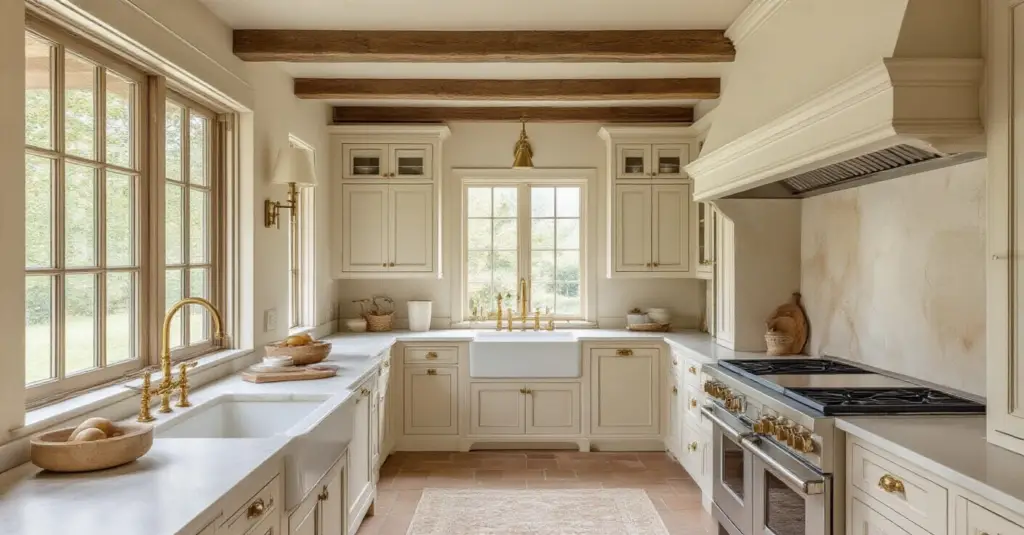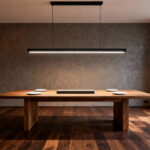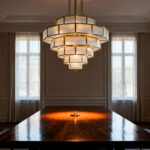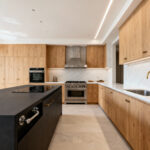You know the question I get all the time about designing a traditional kitchen? People lean in and quietly ask, “How do I make it feel classic without feeling… old?” They have this vision of their grandmother’s kitchen—dark, a little stuffy, and more of a museum piece than a place you’d actually want to hang out in. And they’re worried that by choosing “traditional,” they’re signing up for a look that’s dated from day one.
I get it. Totally. But that’s where everyone gets it wrong. A true traditional kitchen isn’t about replicating a specific year; it’s about drawing from timeless principles of warmth, craftsmanship, and human-centric design that have worked for centuries. It’s about creating a feeling of permanence and comfort in a world of fleeting trends. The goal isn’t to build a time capsule. It’s to build the heart of your home—a place that feels both grounded in history and perfectly alive for your family today. Let’s break down what actually matters and cut through the noise.
Foundational Planning and Style Assessment (Part 1)
Before you even think about a paint chip or a countertop sample, we have to lay the groundwork. This part is the least glamorous, but it’s where you make the decisions that ensure your kitchen feels cohesive and soulful, not like a random collection of “traditional-looking” things you saw on Pinterest.
1. Defining Your Specific Traditional Kitchen Style Niche
Think of “traditional” as a genre of music, like “rock.” That’s way too broad, right? You’ve got classic rock, punk rock, indie rock. They’re all related, but they have a totally different vibe. It’s the same with kitchens. Are you going for the relaxed, sun-bleached feel of a French Country home? The clean, humble lines of an American Shaker kitchen? Or the sophisticated elegance of a Georgian manor? You have to pick your specific flavor.

This isn’t just fussy designer talk. Psychologically, this step is about creating a coherent story. When you have a clear vision—your “niche”—every other decision becomes easier. It gives you a filter. Instead of a million faucet options, you’re looking for one that fits your “English Cottage” story. This clarity is what protects you from creating a space that feels confused and ultimately, unsatisfying. It’s the difference between a kitchen with a soul and one that’s just wearing a costume.
Without this first step, you end up with a beautiful but chaotic puzzle. Moving on, the next piece is ensuring the flow of that puzzle feels as good as it looks.
2. Mastering the Classic Kitchen Layout for Optimal Functionality
Can we talk about the work triangle? I know, it sounds so technical. But the “why” behind it is purely emotional. A good layout is like a dance partner that knows all the moves. It supports you, anticipates your next step, and makes the whole process feel effortless. A bad layout fights you at every turn, creating constant, low-grade stress that you might not even notice until it’s gone. That path you wear into the floor walking back and forth between a poorly placed fridge and sink? That’s physical and mental friction you don’t need in your life.
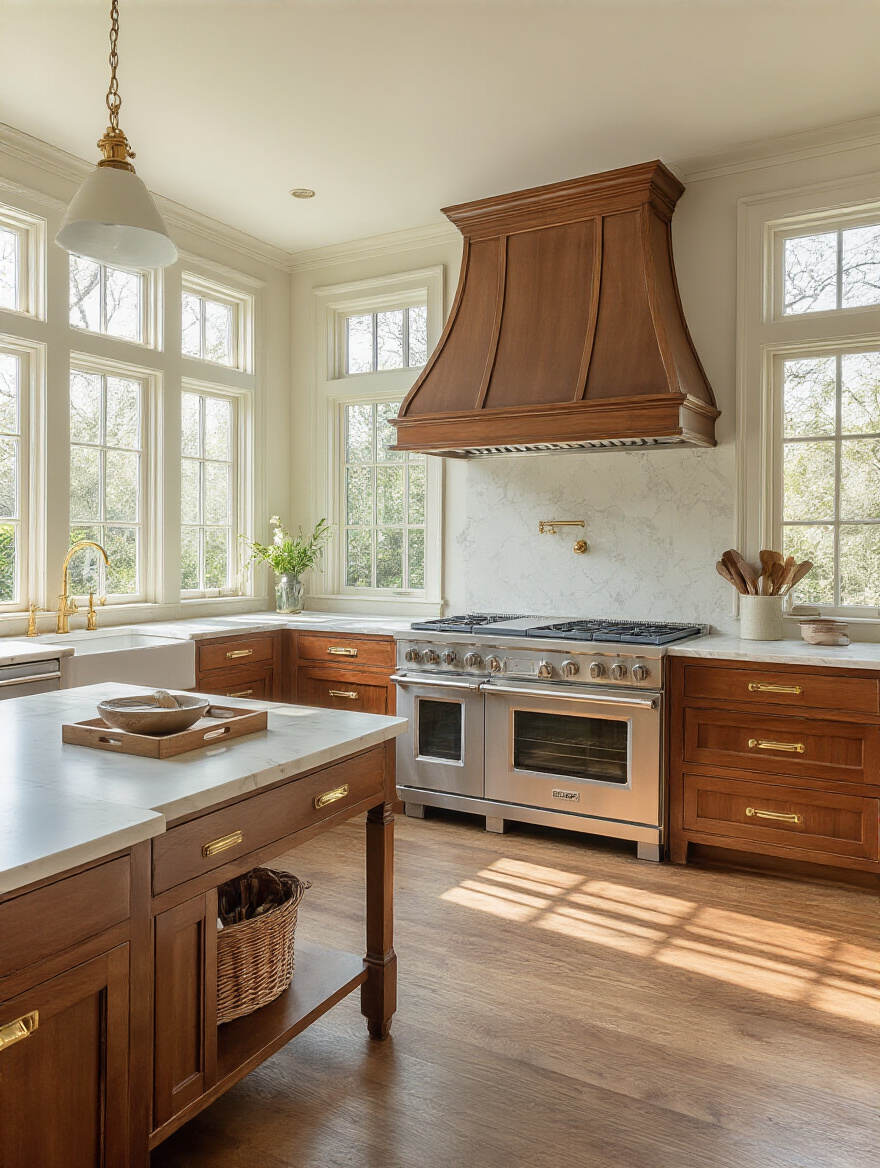
The shortcut here is to not overthink the classic formulas: the U-shape, L-shape, and Galley layouts have survived for a reason. They work. The key is placing your three main zones—refrigerator (storage), sink (cleaning), and cooktop (cooking)—in a way that minimizes steps and keeps them from being blocked by an island or a doorway. It’s not about rigid rules; it’s about creating a zone of calm and competence where the act of making a meal feels fluid and intuitive, not frantic.
An intuitive layout sets the stage for everything you’ll place within it. Now, let’s talk about the biggest visual element that will define that stage: your cabinetry.
3. Selecting Timeless Cabinetry Designs and Wood Finishes
Your cabinets are the architecture of your kitchen. They take up the most visual real estate and set the entire emotional tone. And this is where I see people get swayed by fleeting trends that will date their kitchen in five years flat. The secret is to stick to the classics: Shaker, Inset, and Raised Panel doors have endured because their proportions are balanced and pleasing to the human eye. There’s an inherent sense of order and calm in their simple, confident lines.
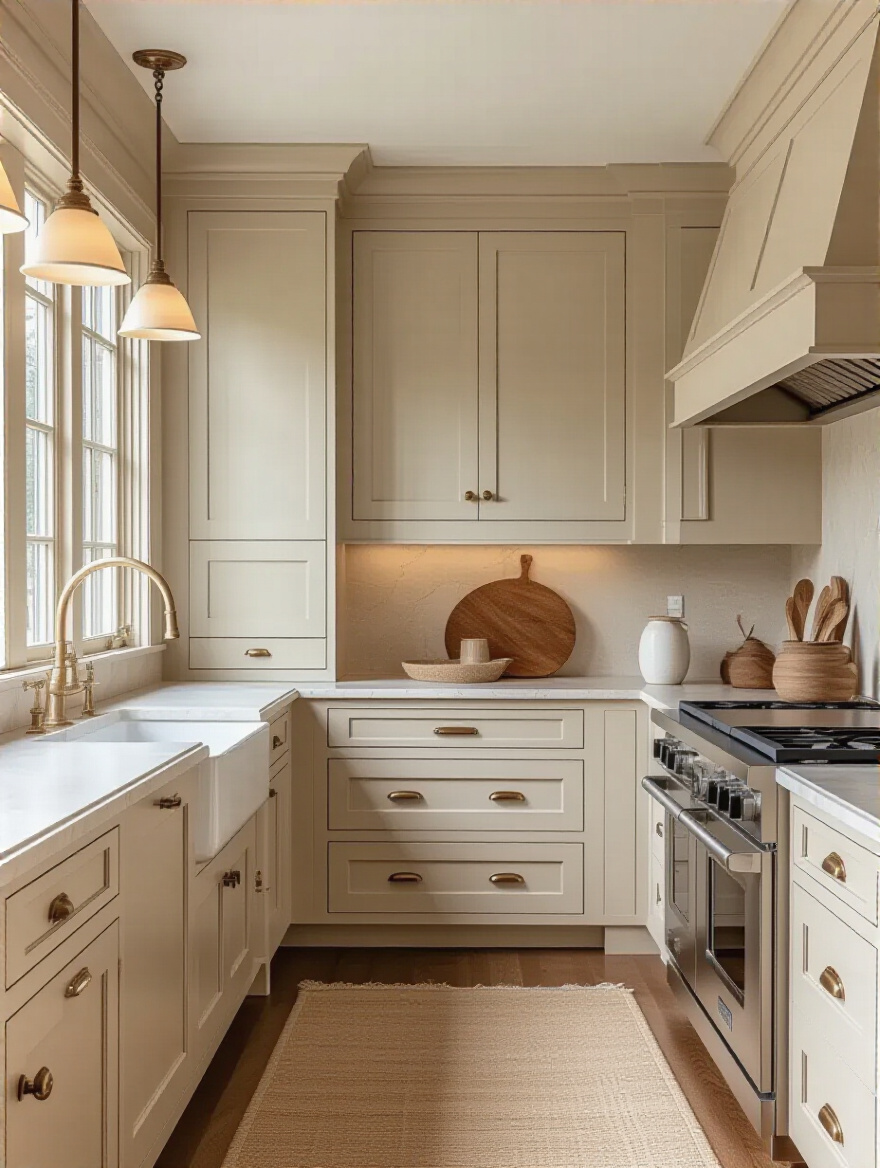
I once worked with a client who was terrified her kitchen would be “boring.” She was drawn to a very ornate, trendy cabinet style. I had her sit with a simple Shaker door sample for a week. She later told me that just looking at its clean lines felt calming, while the ornate one started to feel “loud” and demanding. That’s the power of timeless design. It doesn’t scream for attention. It provides a quiet, steady backdrop for your life. Finishes in classic, neutral paint colors (think warm whites, muted greens, or soft grays) or timeless wood stains give you that same enduring quality.
Of course, what’s beneath your feet is just as foundational as the cabinets in front of you. The right flooring grounds the entire space.
4. Choosing Period-Appropriate Flooring for Authenticity and Durability
The floor is the surface that physically connects you to your home, and your choice here sends a powerful subconscious message. Natural materials like hardwood have a warmth and give underfoot that just feels different. This isn’t just nostalgia; it’s biophilia—our innate human tendency to connect with nature. A beautiful oak or pine floor feels grounding and stable, providing a sense of permanence.
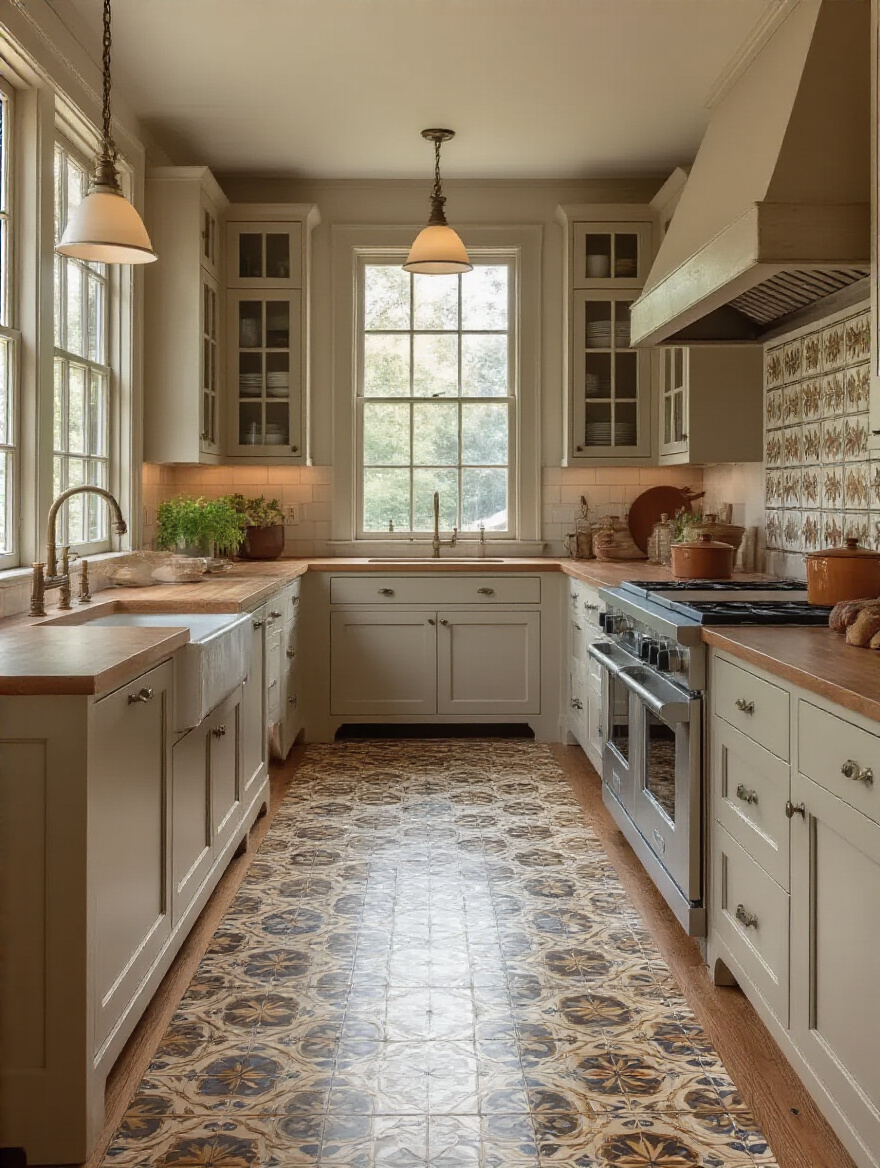
Think about the sound a real wood floor makes versus the click of a synthetic one. Think about how its imperfections tell a story. Choosing something like wide-plank pine for a farmhouse kitchen or a classic black-and-white checkerboard tile for a Victorian-inspired one isn’t about being a historical reenactor. It’s about tapping into an established design language that instantly communicates “comfort,” “home,” and “longevity.” This is the foundation upon which the entire room’s feeling is built.
With these foundational choices locked in, we can build upon them to ensure the space is not just beautiful, but brilliantly functional.
Foundational Planning and Style Assessment (Part 2)
We’ve covered the core “look,” but a traditional kitchen’s soul is truly found in how it functions. This is where we blend classic beauty with the demands of modern life, ensuring the space works as hard as it looks good.
5. Planning for Integrated, Elegant Traditional Storage Solutions
Let’s be honest: clutter creates anxiety. Our brains are hardwired to see visual chaos as unfinished business, which triggers a low-level stress response. This is why great storage is not a luxury; it’s a critical component of a peaceful home. In a traditional kitchen, the magic is in making that storage invisible. The goal is to have a place for everything, tucked away behind beautiful, classic cabinetry.
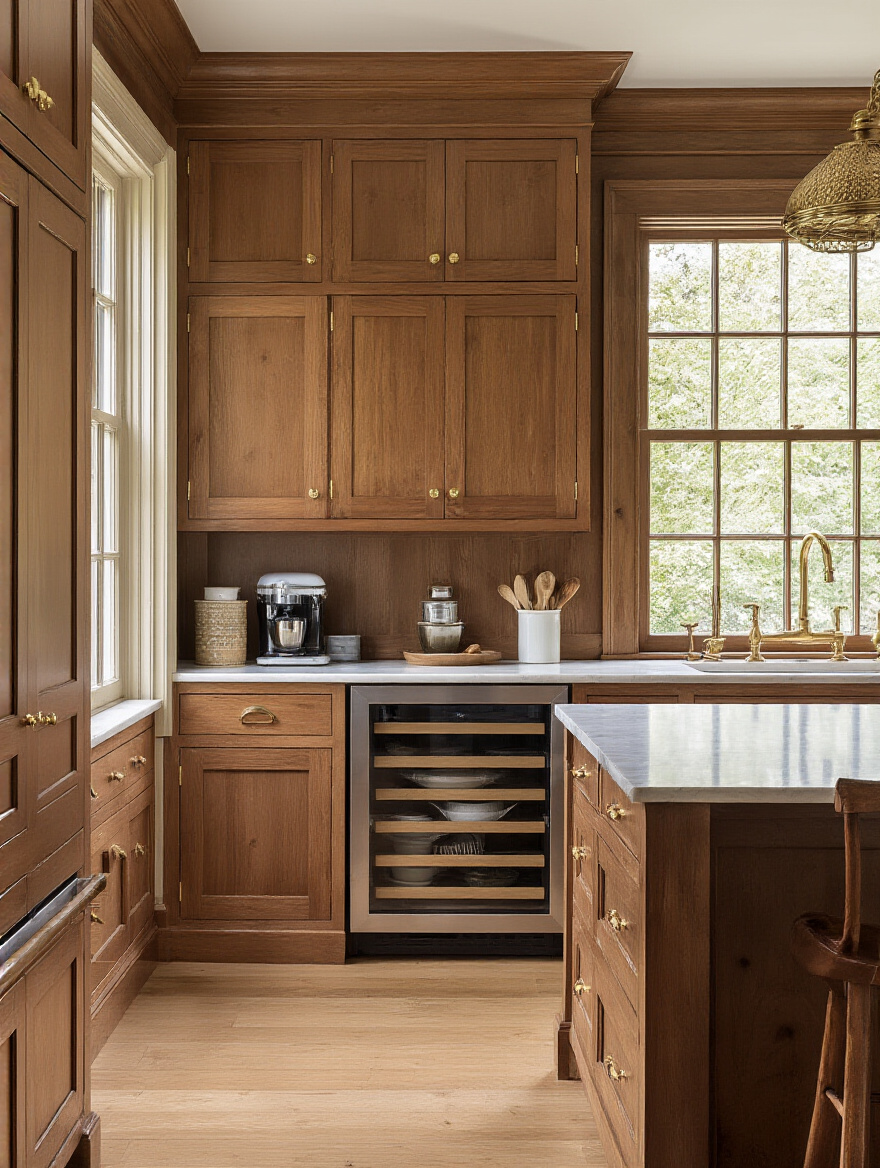
This is about more than just hiding your blender. It’s about designing your kitchen around your life. Think about appliance garages that conceal the toaster and coffee maker behind a seamless cabinet front, or deep drawers with custom dividers for pots and pans instead of a frustrating jumble in a low cabinet. You’re not just organizing things; you’re removing daily points of friction. The result is a kitchen that feels serene and spacious, allowing the beauty of the design—the countertops, the backsplash, the hardware—to truly shine.
That sense of seamlessness extends from storage to the very flow of the room itself. Let’s revisit that work triangle, but with an eye toward a modern aesthetic.
6. Optimizing Work Triangle Efficiency within a Traditional Aesthetic
The classic work triangle is brilliant, but we need to ensure it serves the way we live now without making the kitchen look like a sterile laboratory. It’s about preserving that effortless flow while hiding the modern machine of the kitchen in plain sight. This means being clever with how you place your powerhouse appliances within your traditional design.

Panel-ready refrigerators and dishwashers are your best friends here. They allow these large, modern workhorses to disappear completely into a run of classic cabinetry.
“The most successful traditional kitchens feel like they were thoughtfully updated over time, not designed by a machine. The functionality should whisper, not shout.”
By maintaining the efficiency of the triangle but cloaking it in traditional forms—like placing an apron-front sink as one point and a vintage-style range as another—you get the best of both worlds. The kitchen’s performance is cutting-edge, but its soul remains timeless and warm. It’s this thoughtful integration that makes a traditional kitchen feel both authentic and perfectly suited for today.
Now that the flow and storage are mapped out, it’s time to choose the beautiful, tactile surfaces that will bring the whole vision to life.
Core Material Selection and Key Feature Installation (Part 1)
This is the fun part, where we select the materials that you’ll see, touch, and interact with every single day. These choices are what give a traditional kitchen its depth, character, and enduring strength.
7. Selecting Durable Countertop Materials that Complement Traditional Design
Your countertop is the primary work surface of your kitchen, but it’s also a massive visual and tactile element. The material you choose has a huge psychological impact. Think about the cool, smooth feel of marble or the quiet, matte texture of soapstone. These natural materials have a depth and unique veining that tells a geological story millions of years old. This connection to something real and permanent adds a layer of authenticity that manufactured materials often struggle to replicate.
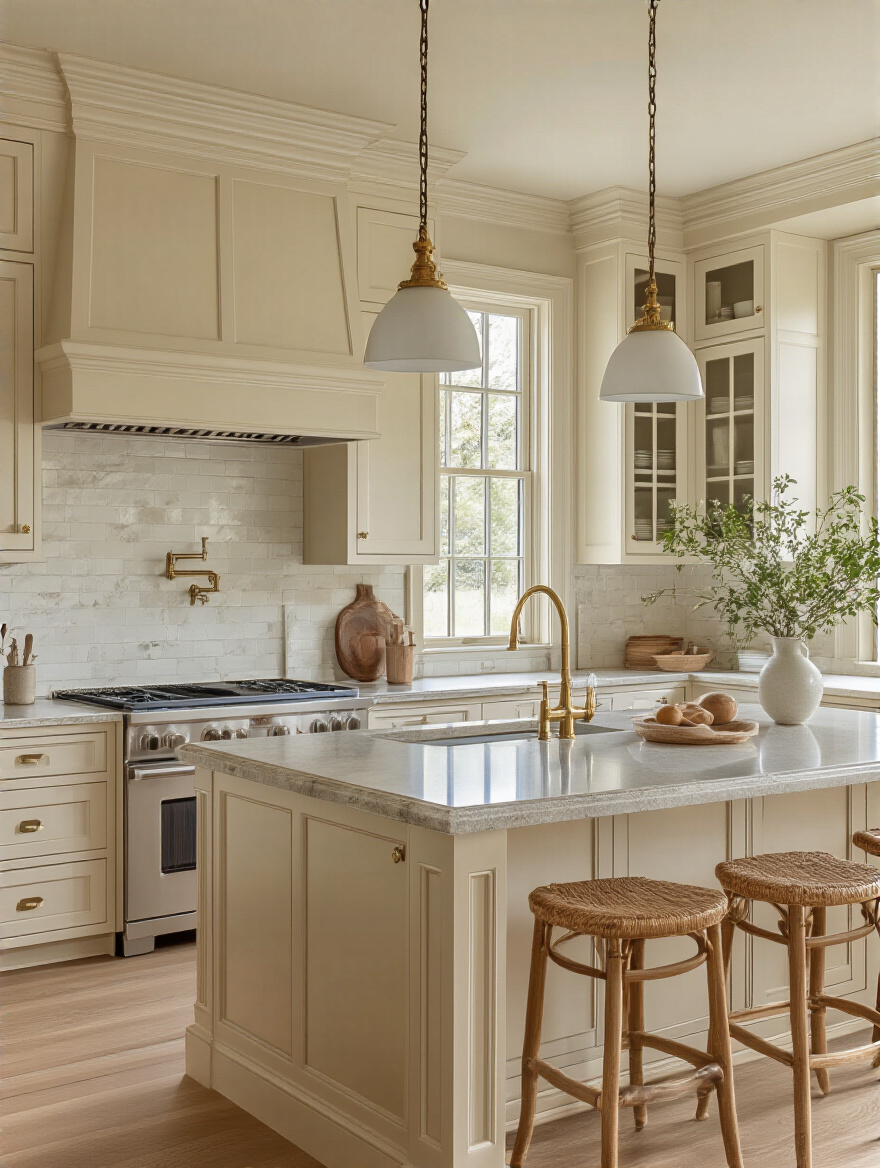
The key is to balance this beauty with real-world durability. A client of mine fell in love with a beautiful, porous white marble but was terrified of stains. We opted for a more durable quartzite with similar veining for the main prep areas and used the precious marble on a less-used island. This is the shortcut: you don’t have to sacrifice. Match the material to the function. Natural stone like granite, the soft patina of soapstone, or even a warm butcher block can all feel perfectly at home while standing up to the demands of a busy kitchen.
Once your main surfaces are chosen, the details that adorn them—the hardware and fixtures—become the critical finishing touches.
8. Sourcing Authentic Hardware and Fixtures for Cohesive Styling
If cabinets are the architecture of the kitchen, hardware is the jewelry. And it’s also the handshake. It’s one of the few things you physically touch dozens of times a day, and the feel of it—its weight, its finish, its shape—sends a constant, subtle message about quality. Flimsy, hollow hardware feels cheap. A solid brass knob or a heavy cup pull feels substantial and permanent.
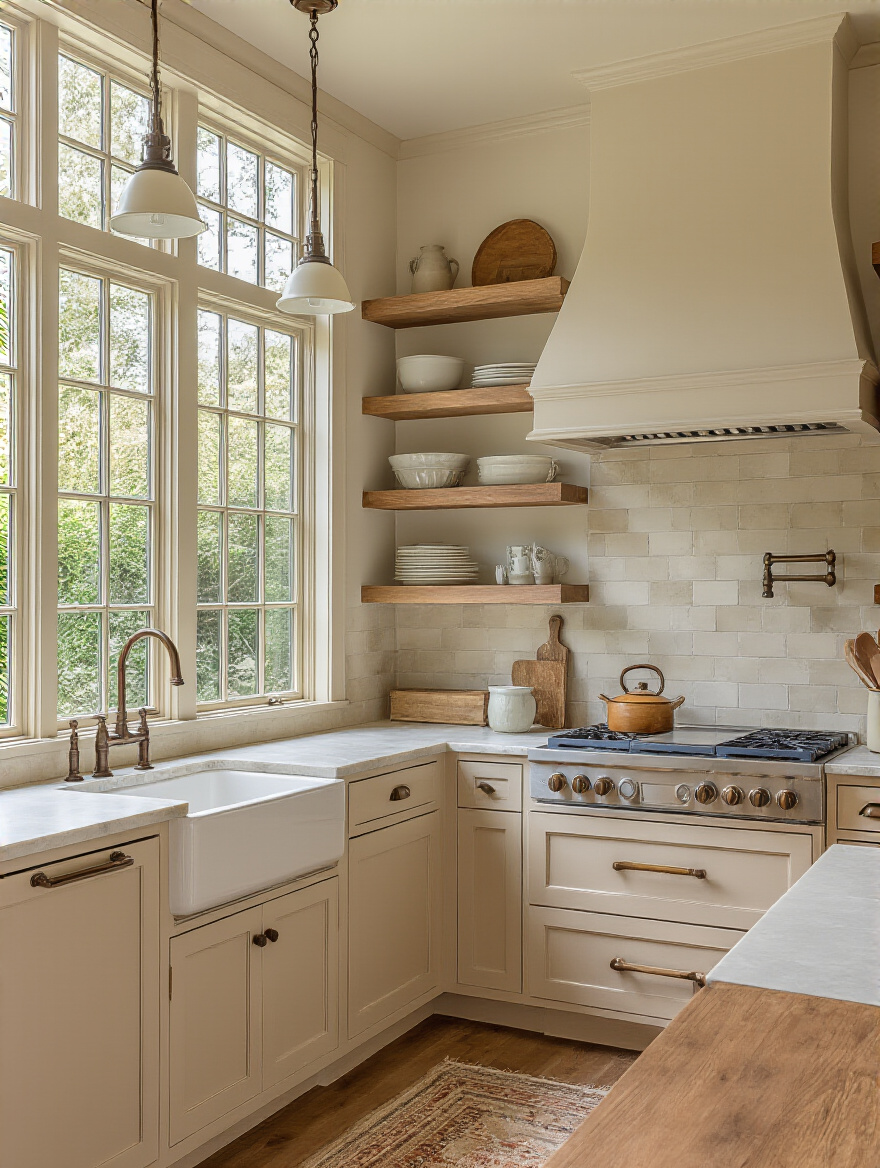
The BS to avoid here is thinking you can skimp on hardware. It’s one of the most impactful, least expensive ways to elevate the entire look and feel of your kitchen. The key is cohesion. Stick to timeless materials like brass, polished nickel, bronze, or iron. Let unlacquered brass develop a natural patina over time; this living finish adds a layer of soul that a factory coating never can. Matching your cabinet pulls to your faucet and light fixtures creates a harmonious visual language that makes the whole room feel intentional and thoughtfully designed.
That same level of intentionality is crucial when you introduce the most modern elements into your classic space: the appliances.
9. Seamlessly Integrating Modern Appliances into a Classic Aesthetic
This is the ultimate balancing act. You want the performance of a 21st-century induction cooktop and a smart refrigerator, but you don’t want a wall of flashing digital displays and stainless steel to shatter the timeless illusion you’ve so carefully built. The secret, once again, is concealment and clever integration.
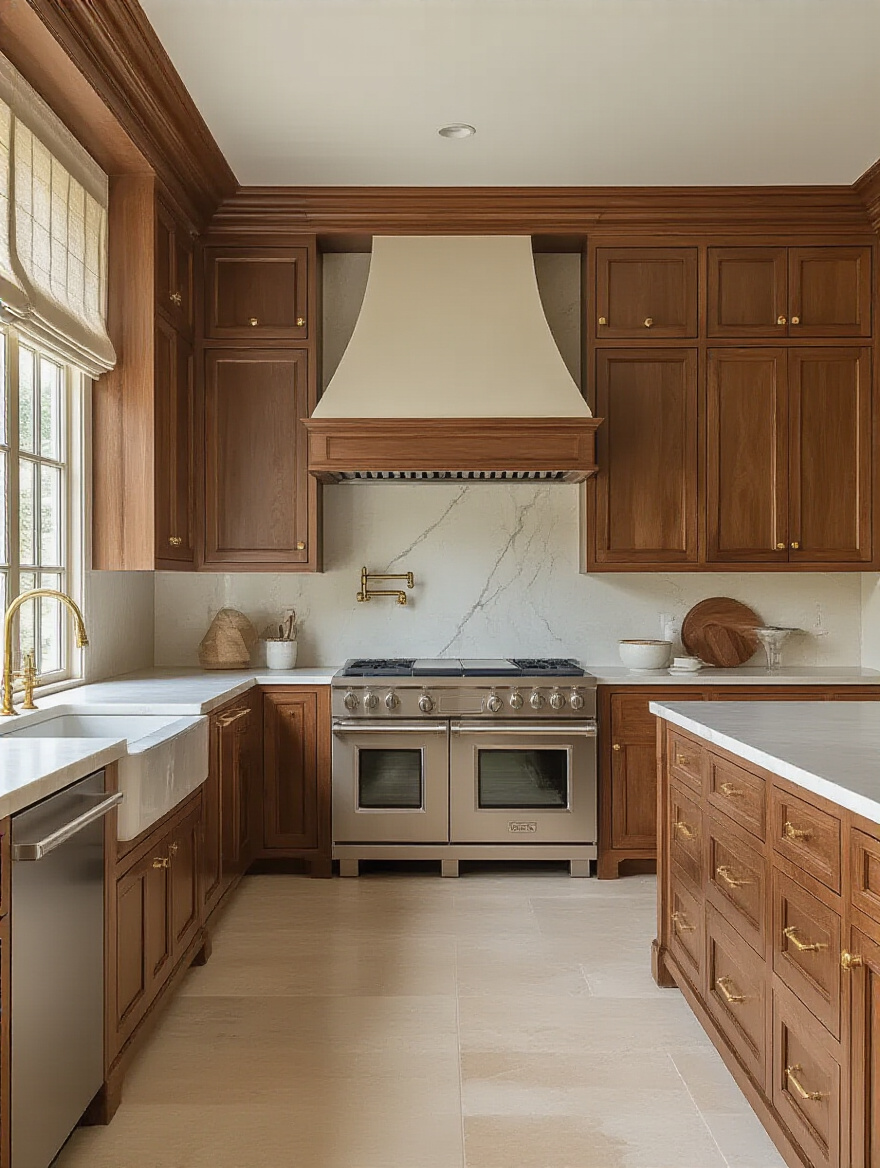
Panel-ready is the gold standard. Hiding your fridge and dishwasher behind custom panels that match your cabinetry is the single most effective way to maintain a cohesive, traditional look. For appliances that can’t be hidden, like a range, choose models that have a classic sensibility. Look for robust knobs instead of touch screens and finishes that complement your hardware. Think of a beautiful Lacanche or AGA range—they are modern machines dressed in timeless clothing. The goal is for your appliances to feel like they belong, supporting the kitchen’s function without visually dominating its classic character.
Just as important as what you can see is how you see it. Let’s talk about the most powerful mood-setter of all: lighting.
10. Illuminating Your Kitchen with Layered Traditional Lighting Fixtures
Lighting is not just about function; it is the single most powerful tool for shaping the emotional atmosphere of a room. So many people get this wrong by installing a grid of recessed lights and calling it a day. This “flat” lighting creates a sterile, shadowless environment that feels more like an office than a home. A traditional kitchen demands layers.
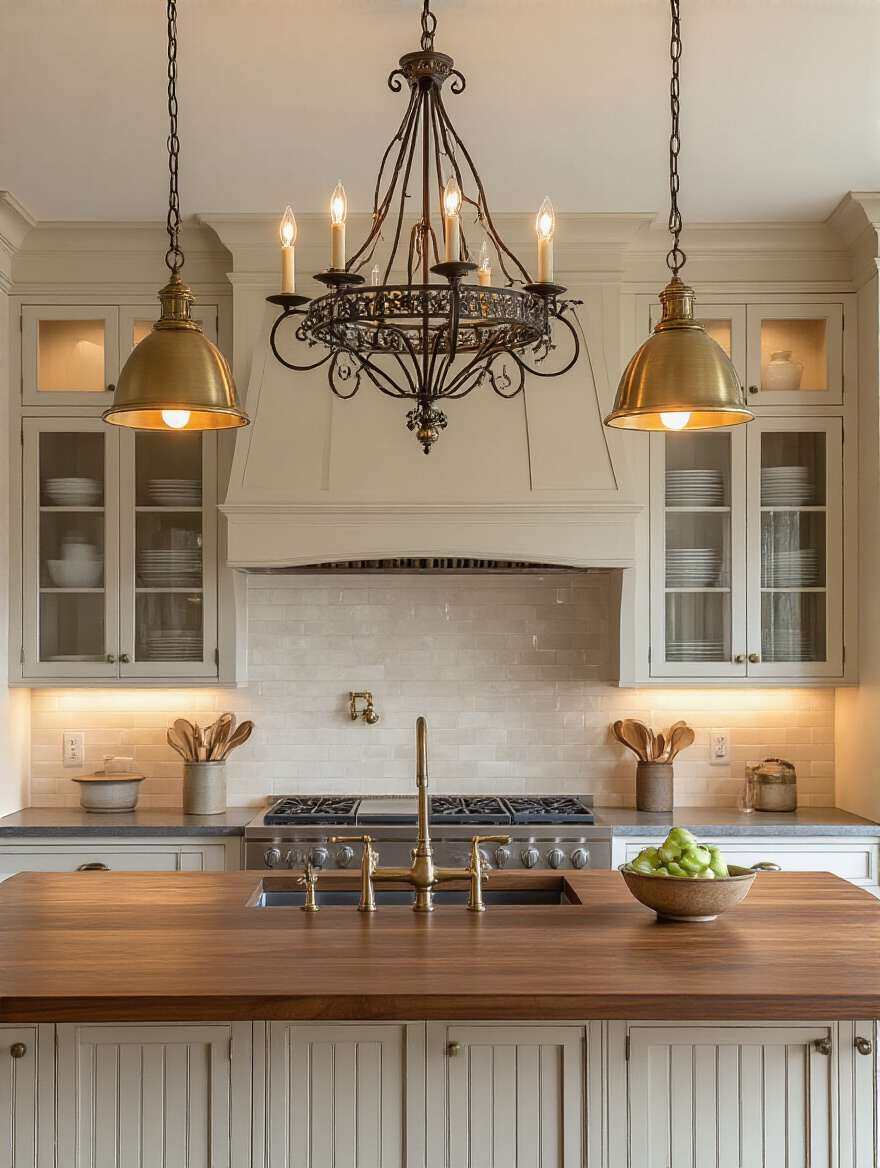
Think of it in three parts:
- Ambient Light: The overall glow. This comes from a central fixture like a beautiful chandelier or a set of flush mounts. It should be warm and inviting (look for bulbs around 2700K).
- Task Light: The focused light for working. This is your under-cabinet lighting, or the pendants over your island. It’s brighter and more direct, making prep work safe and easy.
- Accent Light: The magic. This is the soft light inside a glass-front cabinet that makes your glassware sparkle, or a small lamp on the counter. It adds depth, drama, and a cozy, lived-in feeling.
Putting all your lights on dimmers is non-negotiable. This gives you the control to go from bright, full-task mode for cooking to a soft, warm glow for a quiet evening. You’re not just lighting a room; you’re sculpting the experience within it.
With the core functional and material choices made, we can now focus on the elements that serve as both beautiful features and social hubs.
Core Material Selection and Key Feature Installation (Part 2)
Here, we’ll look at the features that become the gravitational center of the kitchen and the colors that wrap the whole room in a warm embrace. These choices transform the space from a collection of well-designed elements into a single, inviting whole.
11. Crafting a Functional and Beautiful Traditional Kitchen Island or Peninsula
The kitchen island isn’t just extra counter space; it’s the modern hearth. It’s the magnet that draws everyone in. It’s where homework gets done, where friends gather with a glass of wine, and where you lay out a buffet for a party. How you design it directly impacts how people will interact in your kitchen. This is where function and emotional design are completely intertwined.
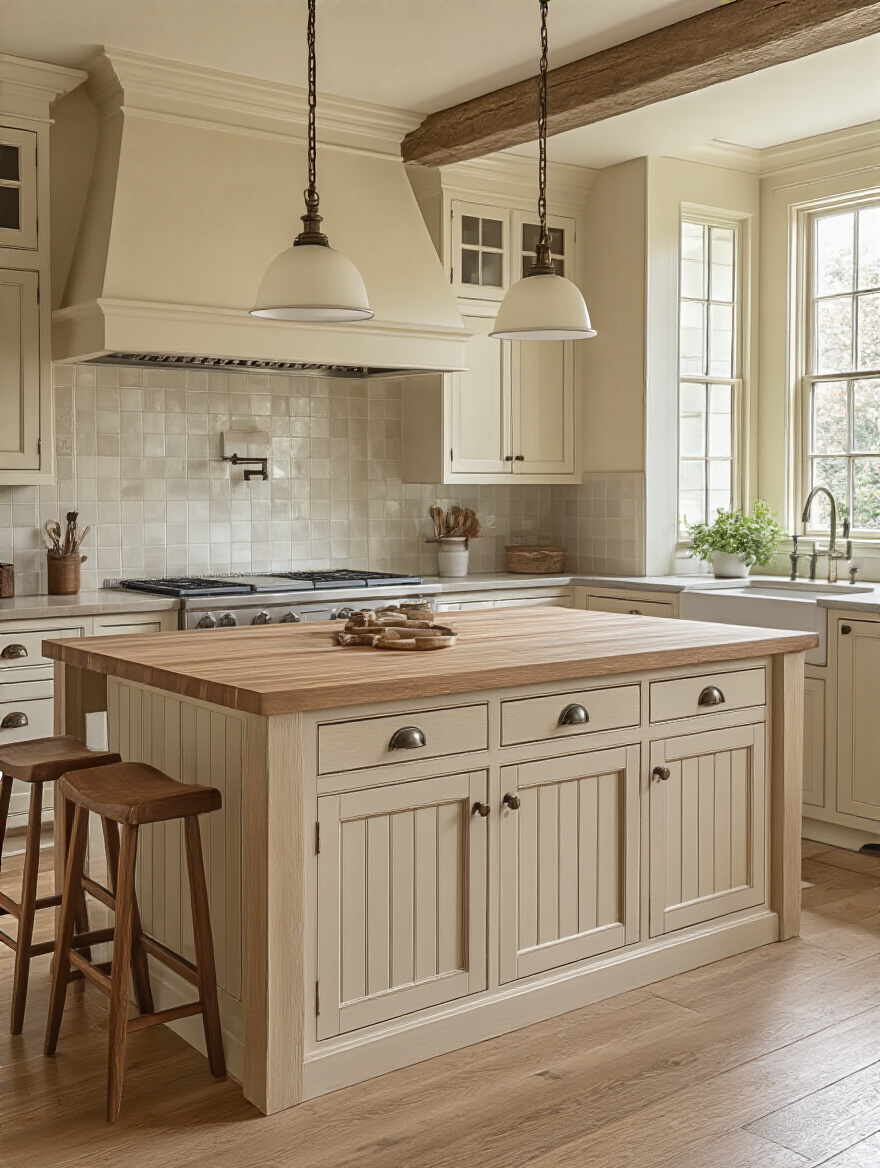
Making it look like a piece of furniture—with turned legs, a contrasting countertop material like butcher block, or a different paint color than the perimeter cabinets—is a classic traditional move. This gives it presence and character, making it feel less like a utility cabinet and more like a cherished family table. Don’t forget the essentials: ensure there are outlets for laptops and chargers, and plan your seating with comfort in mind. Stools with backs and footrests send a clear signal: “Stay a while. You’re welcome here.”
The color you paint that island, and the walls surrounding it, will be the backdrop for all those future memories.
12. Choosing Inviting Paint Palettes and Wall Coverings for Warmth
Color is pure psychology. It’s a language that speaks directly to our emotions, and in a traditional kitchen, we want that language to say “comfort,” “welcome,” and “calm.” The biggest mistake I see is people defaulting to a stark, sterile white, fearing that any color will be too much. But true warmth comes from nuanced, complex colors found in nature.
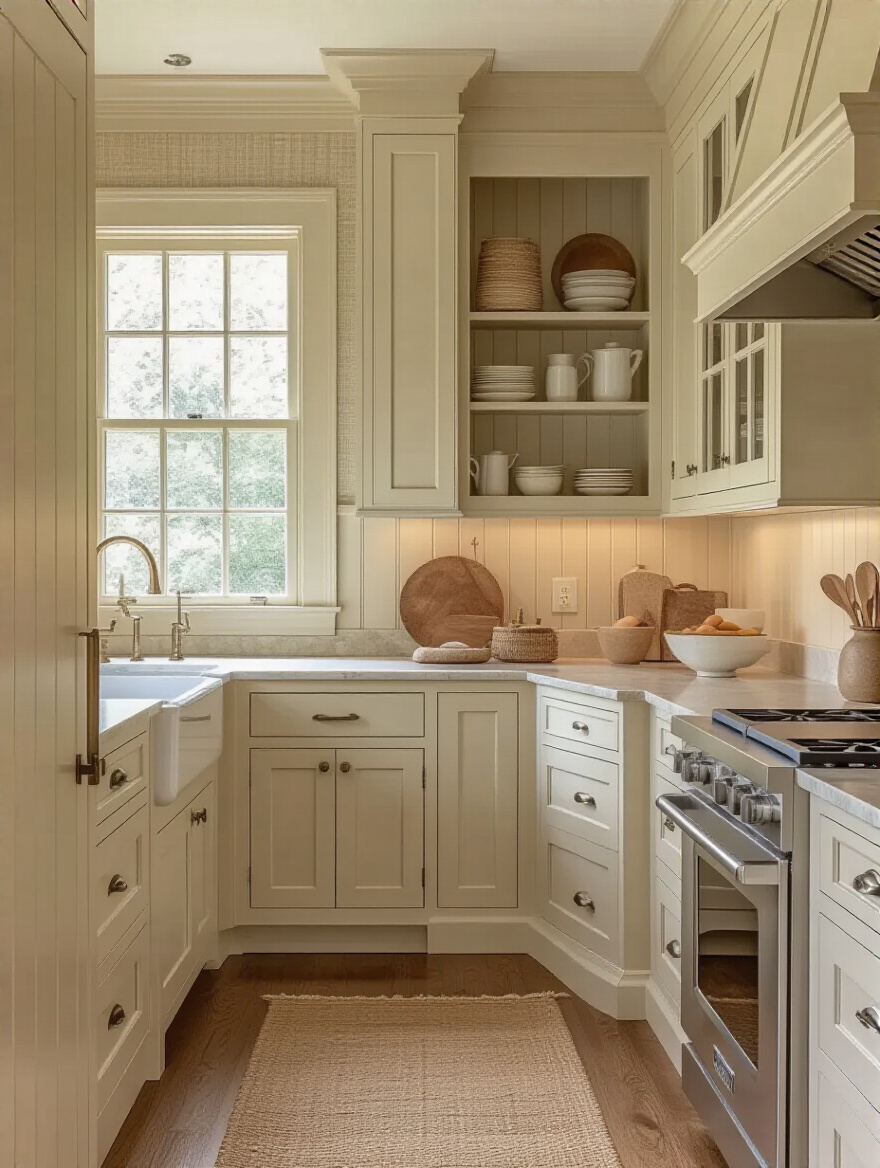
Think of soft, muted sage greens, which are inherently restorative because we associate them with the tranquility of the natural world. Consider warm, creamy whites instead of blue-whites; they have an embracing quality that feels like a hug. Muted blues can feel incredibly serene and stable. The key is to look for colors with a bit of gray or brown in them—this “muddiness” is what makes them feel sophisticated and timeless, rather than bright and childish. Always, always test large swatches on the wall and see how the light changes them throughout the day before you commit.
These colors and materials form the beautiful canvas of your kitchen. Now, it’s time to add the artistic details that give it a unique personality.
Enhancing Ambiance and Decorative Accents (Part 1)
This is where the soul of the kitchen really starts to emerge. We’ve built the beautiful, functional “body,” and now we’re dressing it with personality, comfort, and details that tell your personal story.
13. Designing a Cohesive and Elegant Backsplash that Elevates Charm
The backsplash is your opportunity to add a touch of artistry and texture without overwhelming the space. In a traditional kitchen, it’s not the place for a loud, flashy statement. Instead, it’s about choosing a material with quiet character. Think of handmade subway tiles, where the slight imperfections and variations in the glaze catch the light beautifully. Or consider a honed marble or travertine that adds a soft, chalky texture.
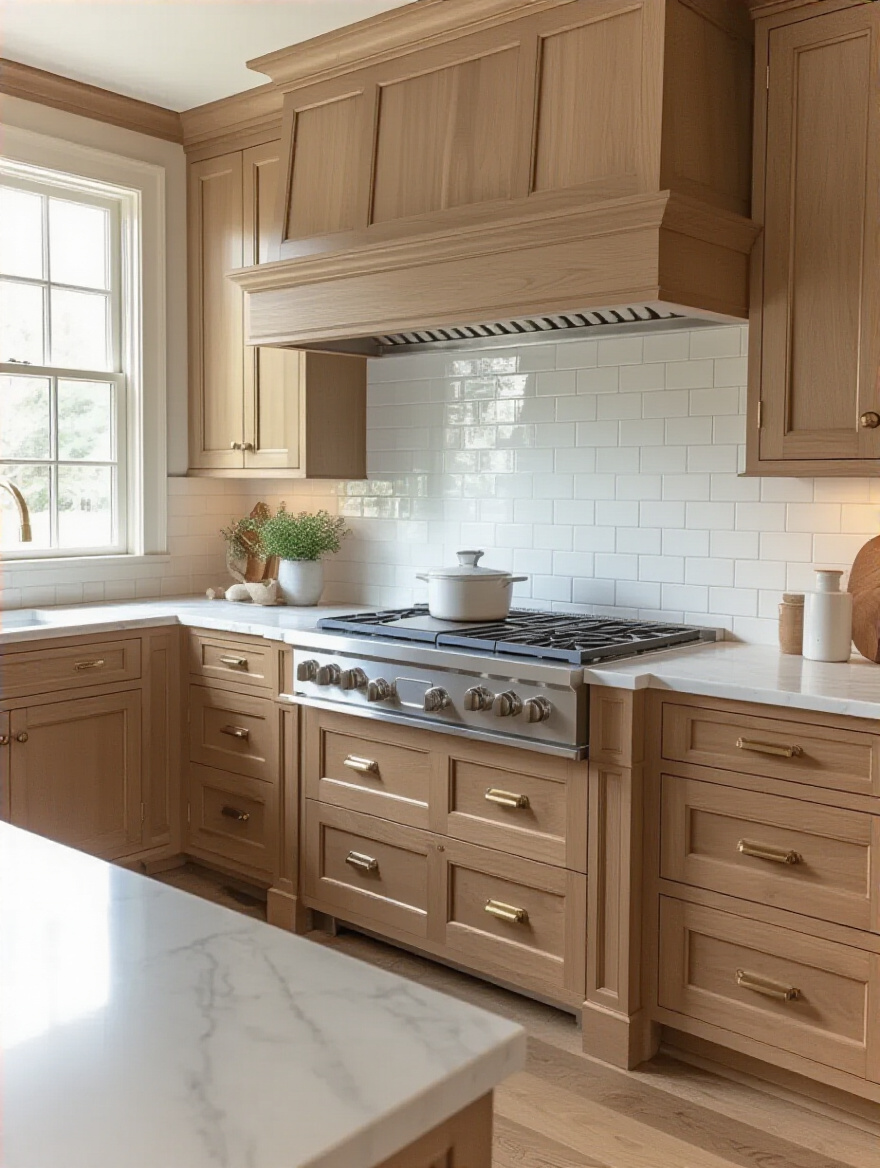
The pattern is just as important as the material. A classic running bond or a herringbone pattern adds a subtle layer of handcrafted detail that reinforces the traditional feel. The shortcut here is to think of your backsplash as a supporting actor, not the star. Its job is to complement the cabinets and countertops, tying them together into a single, cohesive picture and adding a final layer of refined texture.
That same sense of refinement and comfort should extend to the places where you and your guests will sit and linger.
14. Integrating Comfortable and Stylish Seating for Gathering Spaces
The kind of seating you choose sends a powerful, non-verbal cue about how you want your kitchen to be used. Low-profile, backless stools at an island suggest a temporary perch for a quick coffee. But a set of upholstered counter stools with comfortable backs? That’s an invitation to settle in, chat with the cook, and stay for another glass of wine.
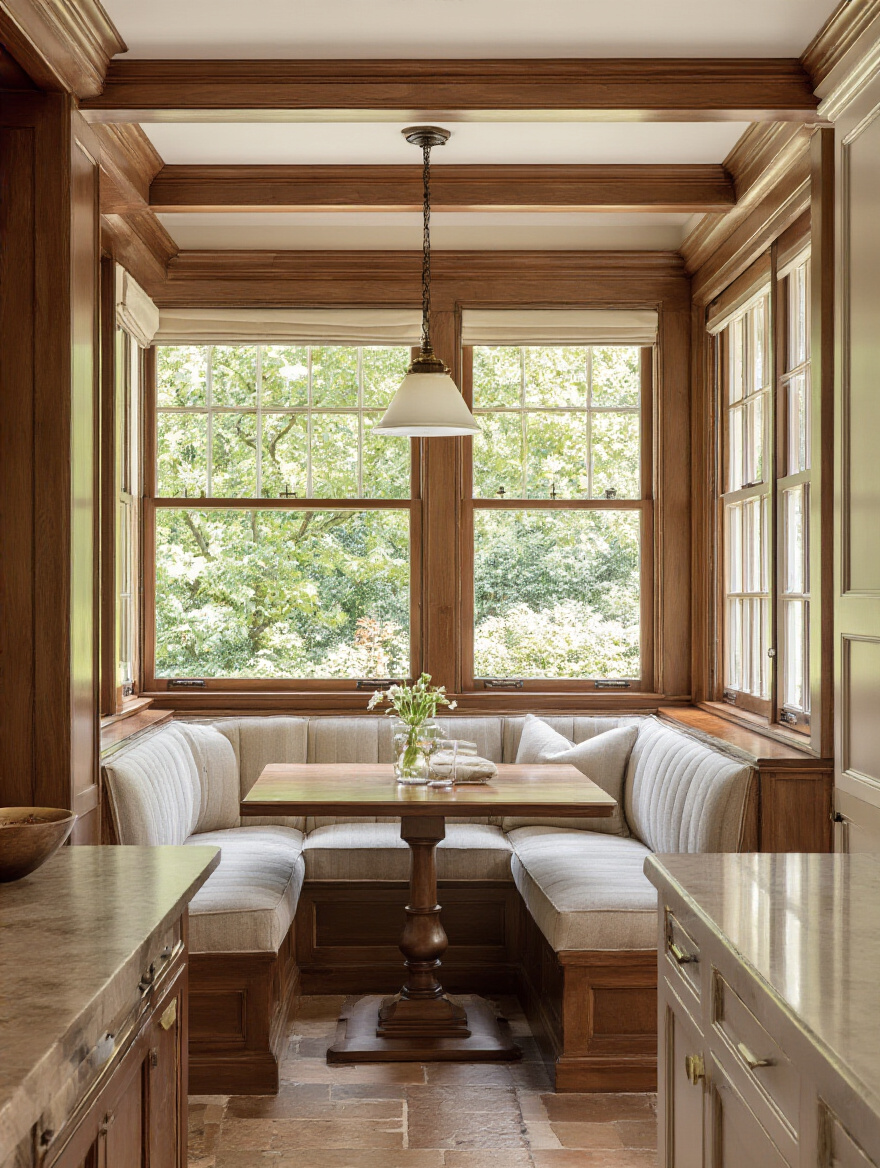
A built-in banquette or breakfast nook is perhaps the ultimate gesture of welcome. Its very form—an embrace of cushions and pillows tucked into a corner—creates a powerful sense of intimacy and coziness. It’s psychologically inviting. Think about how this choice supports the life you want to live. If you envision your kitchen as the central hub for family breakfasts, lazy weekend papers, and kids’ homework sessions, then investing in truly comfortable, inviting seating is one of the most important decisions you’ll make.
And what will people be looking at from those comfortable seats? Let’s consider the windows and how they frame the view.
15. Selecting Graceful Window Treatments for Light and Privacy
Window treatments are the final softening touch for a room. Bare windows can feel stark and cold, but the right fabric can add warmth, control light, and frame your view of the outdoors like a beautiful painting. In a traditional kitchen, the look is tailored and elegant, not fussy or heavy.
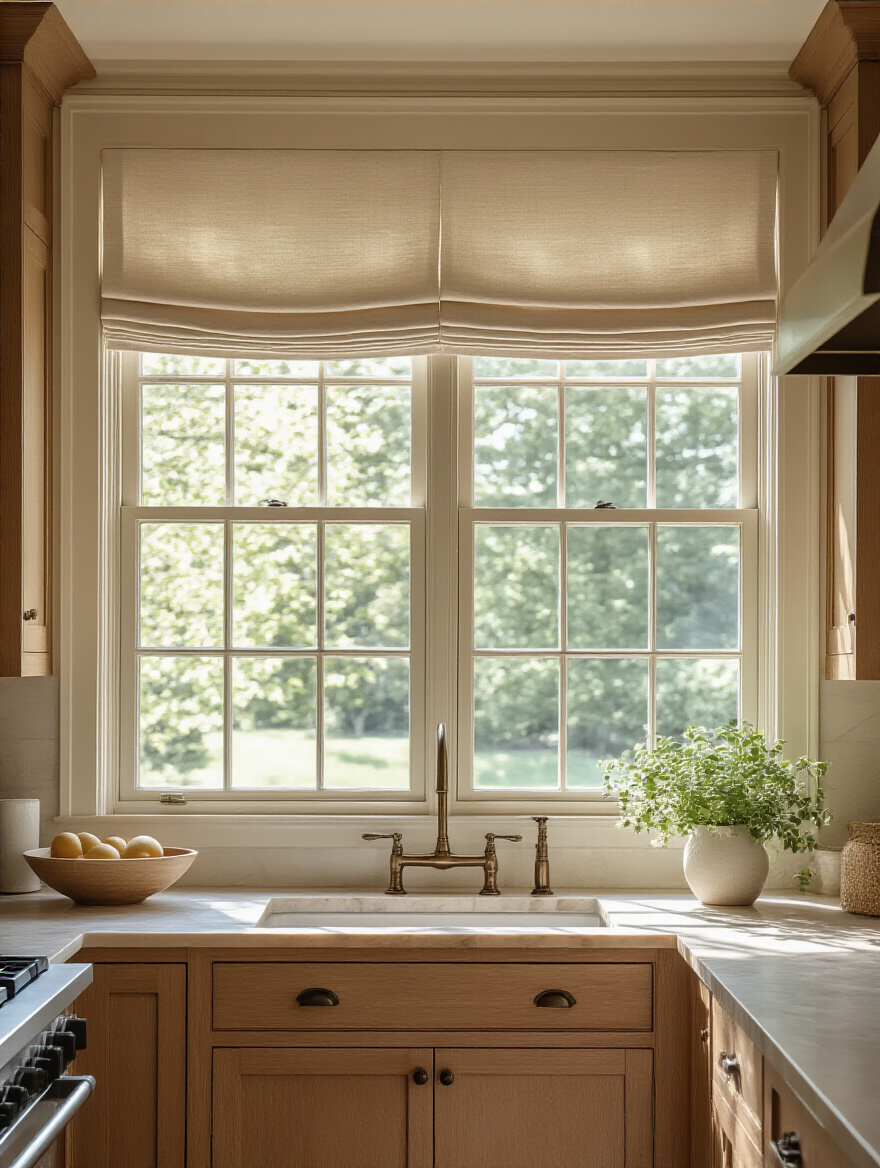
Simple Roman shades in a classic linen or a subtle pattern are a perfect choice. They provide a clean, structured look when up and offer a beautiful, diffused light when down. Café curtains, which cover only the bottom half of the window, are another charming option that gives you privacy while still letting tons of natural light flood the upper part of the room. The key is to choose durable, easy-to-clean fabrics and to avoid anything that feels overly ornate or will collect grease and dust. It’s about adding a final layer of soft texture that makes the whole room feel complete and cared for.
Now for the final flourish: the objects that bring your personal story into the room.
16. Adorning Your Kitchen with Period-Appropriate Decorative Accents
This is where you can truly make the space your own, but there’s a fine line between a curated collection and simple clutter. The rule is this: every object should be beautiful, useful, or both. Think of a collection of antique ironstone pitchers on an open shelf, a vintage oil painting of a landscape leaning against the backsplash, or a beautiful crock holding your wooden spoons next to the stove.
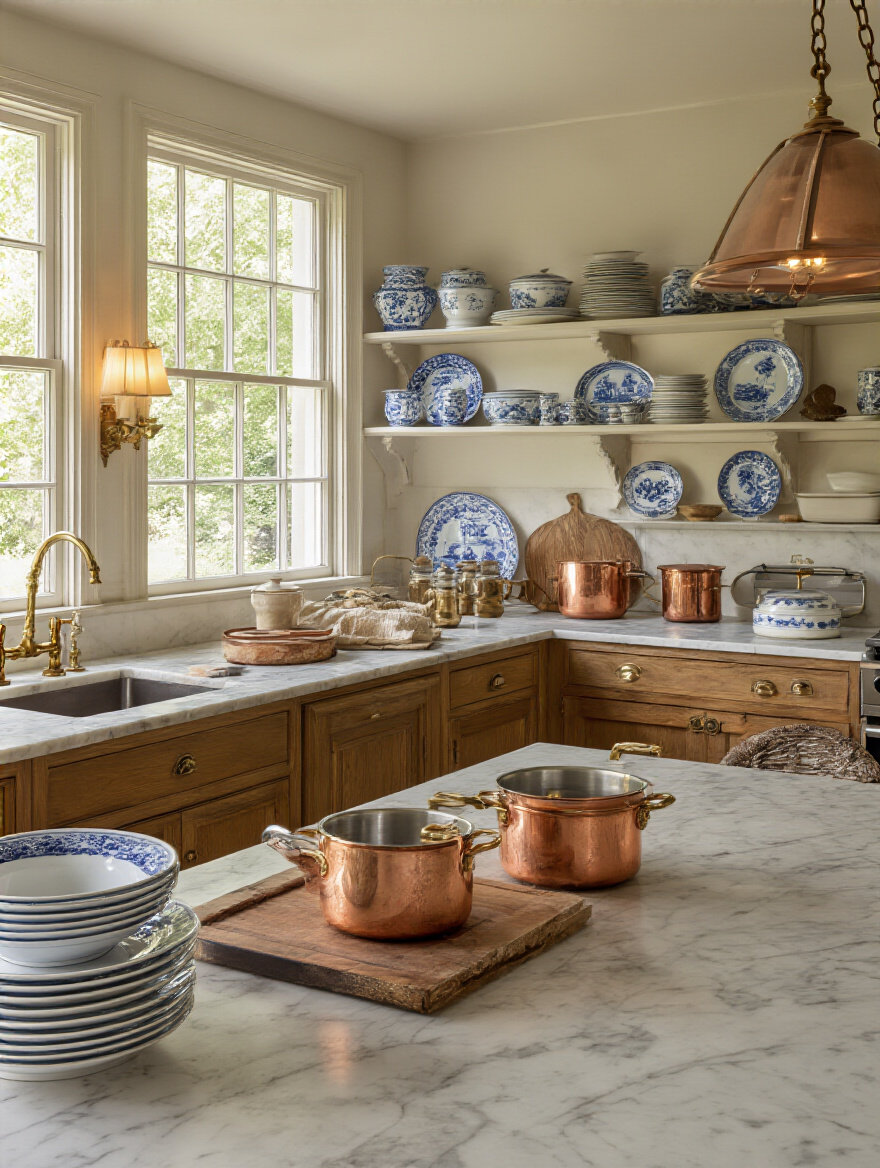
The “why” behind this is that our brains crave story. An object with history or personal meaning brings a layer of soul into the room that a mass-produced “decor item” from a big box store never can. This isn’t about filling every surface. It’s about selective editing. Choose a few meaningful pieces that align with your kitchen’s style niche (the one we talked about way back in step one) and let them have space to breathe. This thoughtful curation is what makes a kitchen feel authentically yours.
This idea of thoughtful layering extends beyond just objects into the very surfaces of the room itself.
Enhancing Ambiance and Decorative Accents (Part 2)
We’ve layered light, color, and objects. Now, we dive into the final, subtle layer that truly elevates a design from good to great: texture. It’s something you often feel more than you consciously see.
17. Introducing Rich Textural Elements for Depth and Visual Interest
A room without texture is a room that feels flat and sterile. Our senses crave variety. In a traditional kitchen, layering different textures is key to creating a rich, inviting, and sophisticated atmosphere. This is the stuff that design magazines are made of, but it’s actually really simple to execute. It’s about creating contrast and a pleasing tactile experience.
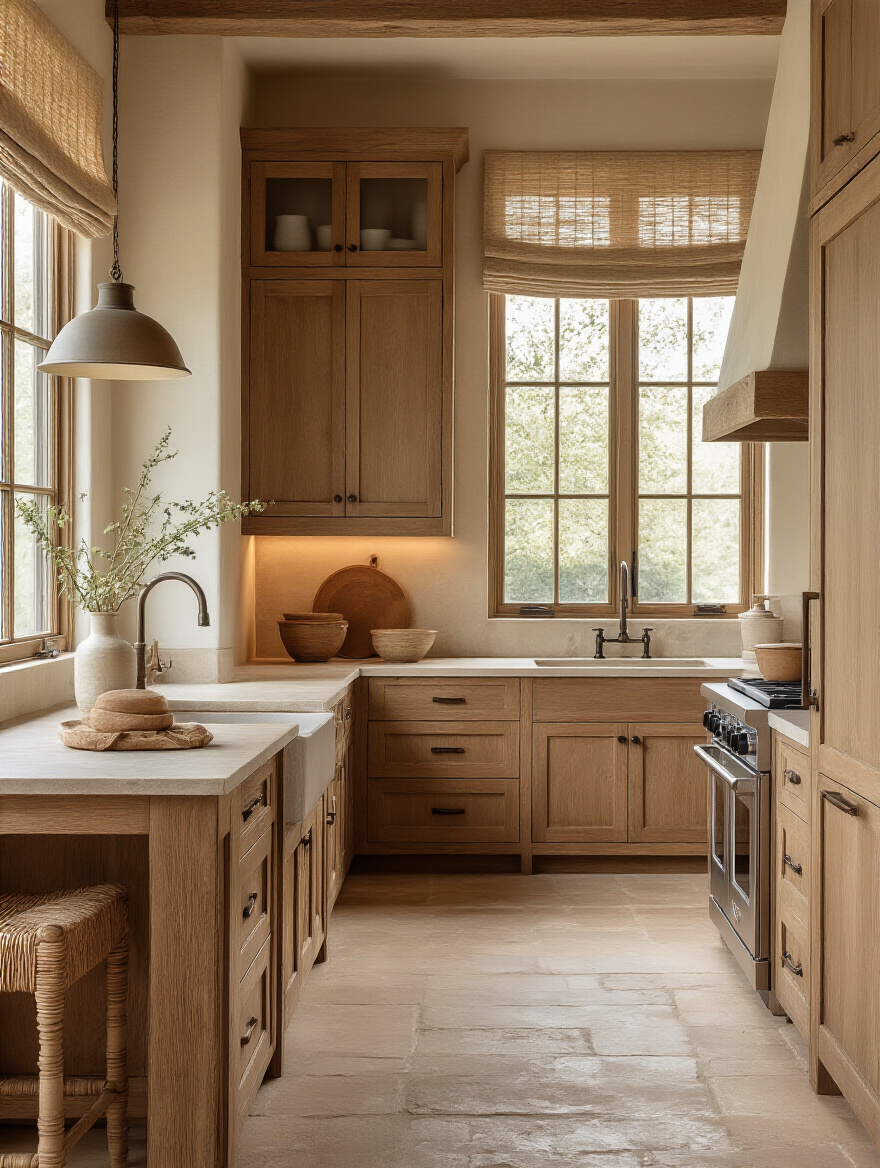
Think about the interplay between different surfaces: the cool smoothness of a marble countertop next to the rough-hewn texture of a reclaimed wood island. The slight texture of a linen roman shade against a smooth, eggshell-finish wall. The polished sheen of brass hardware on a matte-painted cabinet. Each element makes the others more interesting. You can add texture with woven baskets, a nubby wool rug under a kitchen table, or even the subtle pattern of a handmade tile. This is what gives a space its depth and makes it feel complex and real.
Once these sensory layers are in place, the focus shifts to ensuring the kitchen not only looks good today but continues to feel relevant and beautiful for years to come.
Refining Details and Long-Term Maintenance (Part 1)
A truly timeless kitchen is a living space, not a static showroom. It gains character through a mix of old and new, and it endures through smart choices and loving care. Here’s how to ensure your kitchen has a deep soul and a long life.
18. Expertly Mixing Antique Finds with Modern Comforts for Character
The absolute best way to give your traditional kitchen a soul and keep it from looking like a catalog page is to mix in something old. An antique is more than just an object; it’s a storyteller. A salvaged butcher block as an island, a vintage rug in front of the sink, or a piece of art that’s been in your family for generations—these pieces bring a sense of history and uniqueness that you can’t buy new.
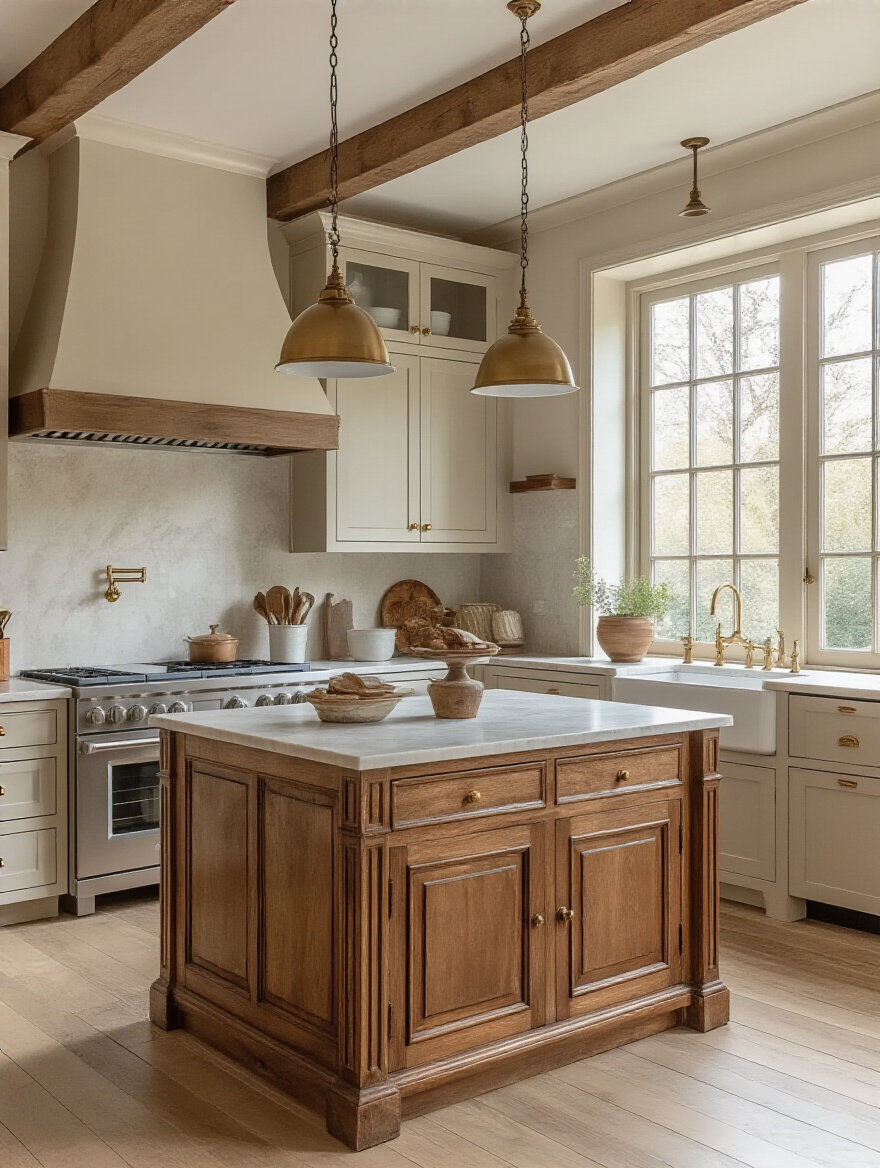
The trick is to create a dialogue between the old and the new. Let that rustic, 100-year-old farm table be surrounded by comfortable, modern chairs. Place a sleek, contemporary lamp on a vintage sideboard. This contrast is what creates energy and personality. The BS everyone falls for is thinking everything has to “match.” It doesn’t. In fact, it’s the artful mismatch, the tension between eras, that makes a room feel curated, personal, and deeply interesting.
For an even deeper level of personalization, nothing compares to creating elements that are designed specifically for you and your space.
19. Commissioning Custom Millwork and Details for Unique Flair
While there are many excellent pre-made options out there, custom millwork is the ultimate way to get a perfect fit and a truly unique feature. This could be a built-in hutch that fits a quirky nook perfectly, a custom range hood that acts as a stunning focal point, or an island designed around your exact workflow and storage needs.
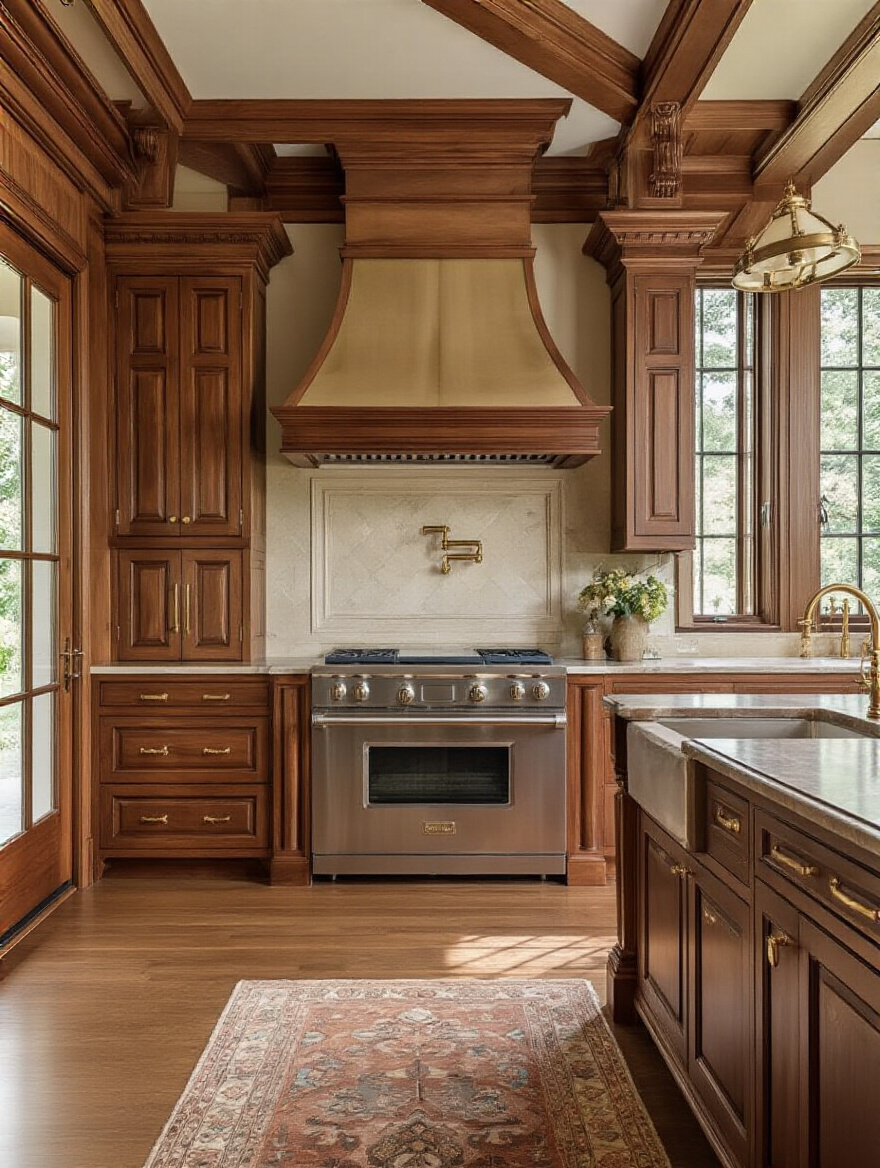
The psychological benefit of a custom piece is immense. It communicates a level of craftsmanship and care that elevates the entire kitchen. More importantly, it solves your specific problems beautifully. That awkward corner becomes a charming breakfast nook; that lack of pantry space is solved by a floor-to-ceiling cabinet that looks like it’s always been there. This is an investment, but it’s one that pays off in daily satisfaction and a kitchen that feels tailor-made for your life.
Whether your cabinets are custom or not, how they function on the inside is just as important as how they look on the outside.
20. Implementing Smart Storage Solutions Without Sacrificing Style
We’ve talked about the importance of storage for creating a calm environment. The next level is making that storage smart. This means using modern interior fittings to make your traditional cabinets work ten times harder. Think of pull-out spice racks next to the range, dividers that organize your baking sheets vertically, or genius blind-corner systems that let you access every single inch of space.

The key is that all this modern magic is happening behind the classic facade of your cabinet doors. I had a client whose beautiful traditional kitchen was always cluttered. We retrofitted her existing cabinets with custom drawer dividers and pull-out shelves. A month later, she told me, “I feel like my kitchen finally works with me, not against me.” You don’t see the mechanisms; you just feel the effortless organization and the resulting peace of mind.
This peace of mind extends to knowing how to protect your beautiful investment for the long haul.
21. Preserving the Beauty of Your Traditional Kitchen with Proper Care
A traditional kitchen is built with beautiful, and often natural, materials. Wood, stone, and metal all have their own needs. Thinking about their care isn’t a chore; it’s a way of honoring the materials and your investment. Using the right pH-neutral cleaner on your marble so it doesn’t etch, or regularly oiling your butcher block to keep the wood from drying out—these are small rituals of care that make a huge difference.
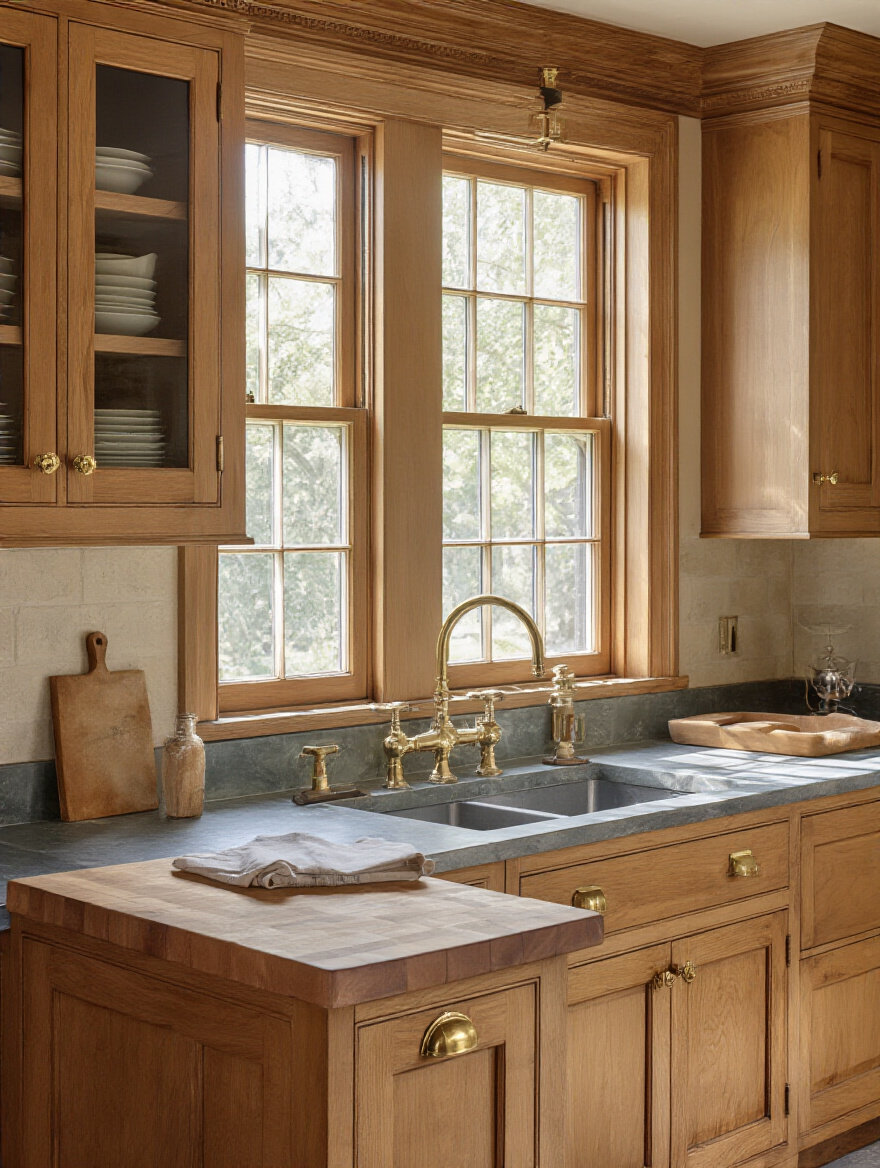
Neglecting this is the fast track to a kitchen that looks tired and worn out before its time. Harsh, abrasive cleaners can permanently damage classic finishes. A small investment in the right cleaning products and a consistent routine will keep your cabinets looking rich, your stone pristine, and your hardware gleaming for decades. This isn’t about frantic cleaning; it’s about mindful maintenance that preserves the beauty and soul of the heart of your home.
That long-term vision is the final piece of the puzzle—designing not just for today, but for all the tomorrows to come.
Refining Details and Long-Term Maintenance (Part 2)
A kitchen is a long-term relationship. The final, and perhaps most important, element is to design it with an eye toward the future, ensuring its timeless appeal is matched by enduring functionality.
22. Adapting Traditional Design for Future Functionality and Enjoyment
Future-proofing a traditional kitchen sounds like a contradiction, but it’s essential. It’s about building a timeless “shell” that can accommodate the inevitable shifts in technology and your family’s needs. This means thinking about things that aren’t obvious right now. For instance, have your electrician run extra conduits for future smart-home wiring. Designate one deep drawer to be a hidden charging station for all your family’s devices.
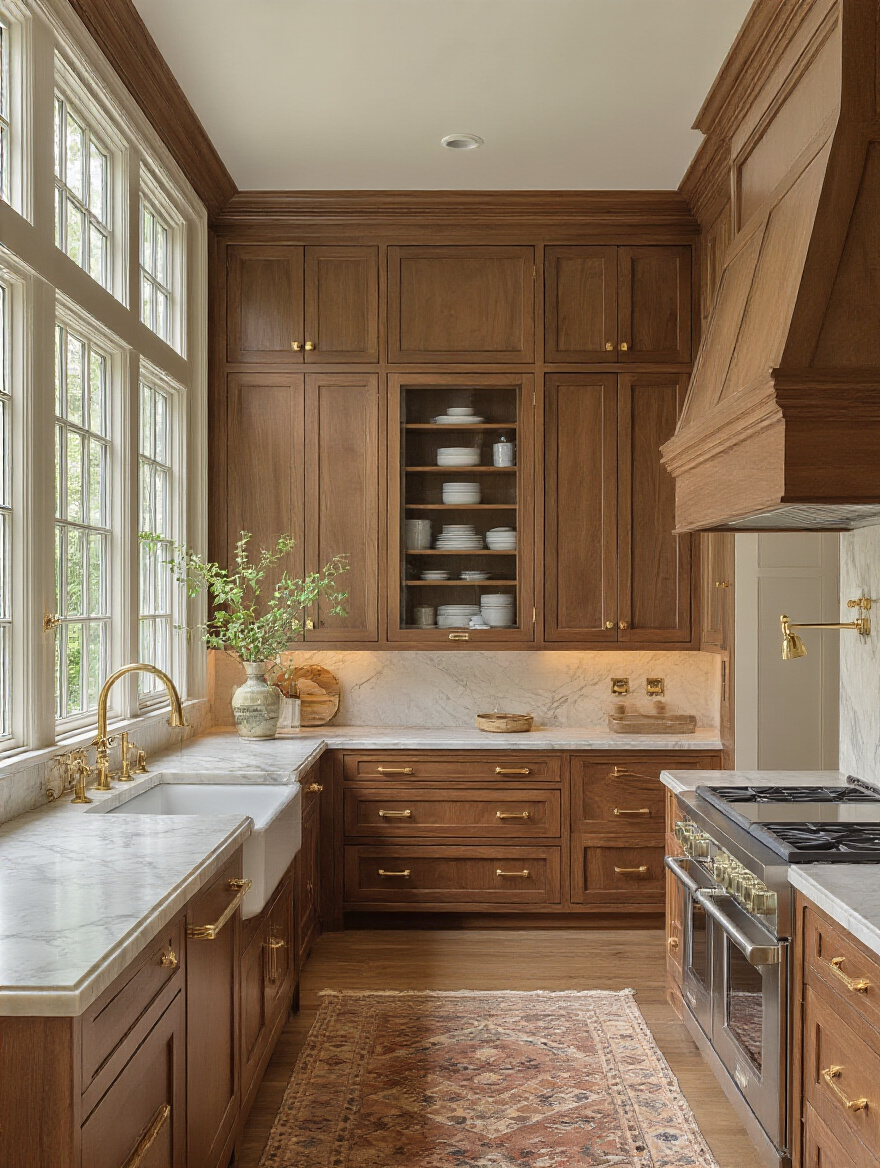
This also applies to universal design principles. Can this kitchen work for you if you have a sprained ankle? Can your aging parents use it easily when they visit? Wider pathways, lever-style handles on faucets, and varied counter heights are all thoughtful inclusions that don’t detract from a traditional aesthetic but dramatically increase the kitchen’s long-term usability. You’re building a beautiful stage not just for the life you have now, but for all the acts yet to come.
Conclusion
So there you have it. Creating a perfect traditional kitchen isn’t about following a stuffy rulebook or making your home look like a museum. It’s about understanding the why behind each choice—the psychology of color, the emotional impact of texture, and the quiet power of a layout that just works. It’s about weaving together elements of craftsmanship, comfort, and personal history to create a space that feels deeply and authentically yours.
The goal is to build a kitchen that ages gracefully, gaining character and soul with every meal cooked and every memory made. It becomes the warm, beating heart of your home, a place that supports, inspires, and welcomes you, day after day. You have the blueprint now. The next step is to start telling your own story, one timeless element at a time. Your dream kitchen is waiting.
